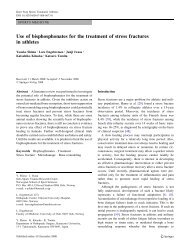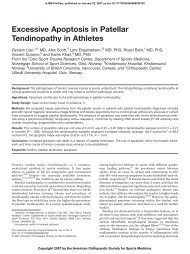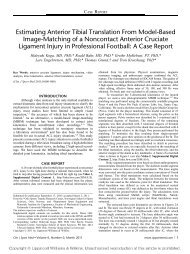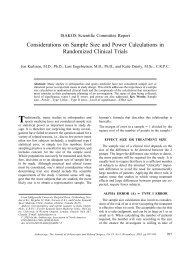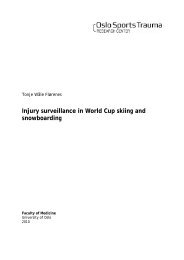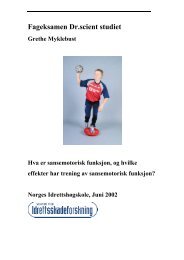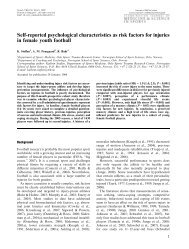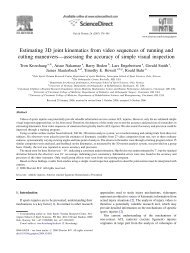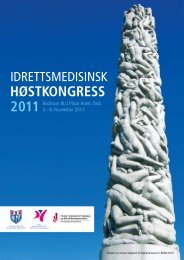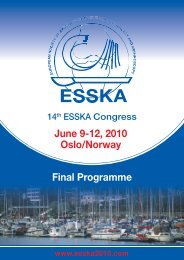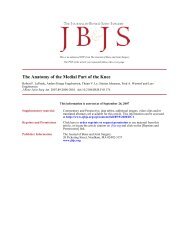ECSS Position Statement 2009: Prevention of acute sports injuries
ECSS Position Statement 2009: Prevention of acute sports injuries
ECSS Position Statement 2009: Prevention of acute sports injuries
Create successful ePaper yourself
Turn your PDF publications into a flip-book with our unique Google optimized e-Paper software.
Downloaded By: [Steffen, Kathrin] At: 02:55 10 June 2010<br />
228 K. Steffen et al.<br />
adductor muscles attempting to decelerate the leg<br />
during a stride in ice hockey. The adductor muscles<br />
can also be strained in a forceful concentric contraction,<br />
as during a kick after a ball in the air. The<br />
iliopsoas muscle can be <strong>acute</strong>ly strained if a forceful<br />
hip flexion is interrupted suddenly, as if tackled or<br />
hitting the ground when kicking, but also during an<br />
eccentric contraction (Árnason et al., 2004; Maffey<br />
& Emery, 2007; Meeuwisse et al., 2007).<br />
<strong>Prevention</strong><br />
A previous groin injury is the best established risk<br />
factor, emphasizing the need for adequate rehabilitation<br />
<strong>of</strong> the primary groin injury before returning to<br />
<strong>sports</strong> (Árnason et al., 2004; Hägglund et al., 2006;<br />
Steffen et al., 2008a). It is unclear whether stretching<br />
<strong>of</strong> the adductor/abductor and iliopsoas muscles can<br />
prevent groin <strong>injuries</strong>. However, a functional flexibility<br />
<strong>of</strong> these muscles and range <strong>of</strong> motion <strong>of</strong> the hip<br />
joint may be important (Árnason et al., 2004).<br />
As many groin <strong>injuries</strong> occur during eccentric<br />
loading, reduced eccentric strength <strong>of</strong> the adductor<br />
muscles has been suggested as a possible risk factor.<br />
However, studies on different athlete populations<br />
(ice hockey, soccer) do not provide conclusive<br />
evidence for general strengthening exercises as a<br />
prevention method (Maffey & Emery, 2007). Nevertheless,<br />
an intervention study including specific<br />
strength training <strong>of</strong> the adductor muscles (static,<br />
concentric, and eccentric), as well as core stability<br />
exercises for the pelvic muscles showed a highly<br />
significant effect in the treatment <strong>of</strong> adductor-related<br />
groin <strong>injuries</strong> (Hölmich et al., 1999). However, this<br />
programme has not been evaluated as a primary<br />
prevention method, although such exercises are<br />
commonly included in general prevention programmes<br />
for lower extremity <strong>injuries</strong>.<br />
Thigh<br />
Injury characteristics<br />
Common thigh <strong>injuries</strong> are contusions to the anterior<br />
and lateral thigh and strains to the quadriceps or<br />
hamstring muscles. A hamstring strain is the most<br />
common type <strong>of</strong> injury in many <strong>sports</strong>, particularly in<br />
the football codes, which are characterized by sudden<br />
accelerations and decelerations, <strong>of</strong>ten followed by<br />
changes <strong>of</strong> direction, and eccentric muscle activity<br />
during sprinting and kicking (Árnason et al., 2004;<br />
Askling, Tengvar, Saartok, & Thorstensson, 2008;<br />
Hägglund et al., 2006; Mjølsnes, Árnason, Østhagen,<br />
Raastad, & Bahr, 2004). Recent studies suggest that<br />
the proportion <strong>of</strong> hamstring strains has increased in<br />
soccer during the past decade, as the sport has become<br />
more physically demanding with more frequent and<br />
higher intensity runs (Árnason et al., 2004; Hägglund<br />
et al., 2006). Sports characterized by slow stretching<br />
beyond the usual movement <strong>of</strong> the muscles, in<br />
particular hip flexion (e.g. dancing), also have high<br />
rates <strong>of</strong> hamstring <strong>injuries</strong> (Askling et al., 2008).<br />
Risk factors<br />
The two factors most consistently associated with a<br />
hamstring strain injury are a history <strong>of</strong> previous<br />
injury and age (older players with higher risk)<br />
(Árnason et al., 2004). Some studies indicate that<br />
decreased hamstring strength (concentric and eccentric),<br />
low hamstring-to-quadriceps strength ratio,<br />
and a side-to-side difference in hamstring strength<br />
could be risk factors for hamstring strains (Murphy,<br />
Connolly, & Beynnon, 2003). Poor flexibility <strong>of</strong> the<br />
hamstring muscles has also been suggested as a risk<br />
factor for muscular strains (Murphy et al., 2003).<br />
However, there is a paucity <strong>of</strong> evidence, and the<br />
methodology has been poor, thereby not allowing<br />
definitive conclusions to be drawn.<br />
Mechanisms<br />
Most hamstring strains occur during maximal sprinting<br />
activities in the late swing phase, when the<br />
hamstring muscles are loaded eccentrically to decelerate<br />
the forward movement <strong>of</strong> the leg, or at<br />
foot-strike, in the transition from eccentric to concentric<br />
muscle action (Árnason,Andersen,Holme,<br />
Engebretsen, & Bahr, 2008; Askling et al., 2008;<br />
Proske, Morgan, Brockett, & Percival, 2004). It has<br />
therefore been postulated that eccentric overload could<br />
cause tearing in the muscle tendon unit (Árnason et al.,<br />
2004; Garrett, 1990; Maffey & Emery, 2007).<br />
<strong>Prevention</strong><br />
Based on the injury mechanism, it has been suggested<br />
that eccentric strength is important to prevent hamstring<br />
strains. There is good evidence that eccentric<br />
strength training <strong>of</strong> the hamstring muscles increases<br />
hamstring muscle torque more effectively than concentric<br />
hamstrings training (Askling, Karlsson, &<br />
Thorstensson, 2003; Mjølsnes et al., 2004) and<br />
reduces the incidence <strong>of</strong> hamstring strains in elite<br />
male soccer players (Árnason et al., 2004; Askling<br />
et al., 2003; Mjølsnes et al., 2004). The Nordic<br />
hamstring lower exercise is a partner exercise in which<br />
the athlete attempts to resist a forward-falling motion<br />
<strong>of</strong> the upper body using the hamstring muscles to<br />
maximize loading in the eccentric phase. In a study on<br />
Norwegian and Icelandic male soccer players, this<br />
exercise reduced the risk <strong>of</strong> hamstring strains by 65%<br />
(Árnason et al., 2008). There is little or no evidence in<br />
the literature to suggest that flexibility training alone



